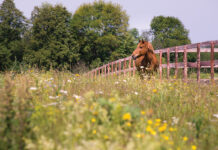
The nuisance factor is huge, from the incessant stomping and swishing to trail rides cut short by swarms of bugs, not to mention training sessions interrupted by the buzz of attacking mosquitoes. But the risk of disease is even more important. From pigeon fever to West Nile Virus, these insects can inflict damage far outweighing the irritation they cause.
Many of us turn to the fast and easy solution: fly spray. We douse our horses with our favorite brand, providing at least temporary respite from the bugs. However, there are many other steps we can take to protect our horses and ourselves from both the frustration and danger posed by flies and their fellow flying insects.
Fly Sprays
Fly spray is an obvious solution to the immediate problem. Spray your horse, and the bugs are gone. That’s the idea, at least, to provide fly protection for your horse.
Natural vs. Chemical
The effectiveness of fly sprays depends on many factors. First, there are two basic types: natural and chemical formulations. Natural fly spray formulas use one or more herbal extracts and/or essential oils, such as citronella, lemongrass, eucalyptus and lavender.
Most chemical-based fly sprays contain insecticides, such as pyrethrin or pyrethroids, as the primary active ingredients. The most significant difference is that natural formulas will repel flies and other insects, but not kill them. Fly sprays containing insecticides kill as well as repel insects. The bottom line is that if your horse simply can’t tolerate bugs, then a natural formula might not be as effective as you need.
Water or Oil-Based
If you opt for a fly spray containing insecticides, the next decision is water- or oil-based. There are pros and cons to each.
Oil-based sprays are more impervious to sweat and rain, and have the added advantage of giving some shine to the coat. However, that oil also attracts and holds dust and dirt, and some horses are more sensitive to oil-based products.
Water-based sprays can be less likely to cause skin irritation and don’t attract dust. Many manufacturers add ingredients such as aloe and lanolin to help water-based products be less susceptible to sweat and rain, resulting in longer-lasting effectiveness.
Cost
There’s a reason some fly sprays cost more than others, with higher prices typically reflecting higher percentages of active ingredients, as well as additional ingredients that bolster the spray’s performance.
Higher percentages of active ingredients translate to stronger, longer-lasting effectiveness. So while that inexpensive bottle seems like a bargain, in reality, it might not be providing the protection you want.
Following Directions
Be sure to read the instructions, as many manufacturers recommend you brush the hair up and spray against the hair. Following these directions can help increase the effectiveness or longevity of the spray.
Make sure your horse is clean and dry before spraying. Use enough product to dampen, but there’s no need to soak the horse. Plus, over-application can lead to skin irritation. Be sure to get the chest, underside and legs, but never spray around the ears, eyes and muzzle. Instead, use a towel to apply spray to sensitive areas.
Ointment
Fly ointments are another option for on-horse protection. Typically, these are applied to sensitive or hard-to-reach areas.
Gnats in particular often choose a place to “chew” on a horse, such as inside the ears, on the chest, or along the horse’s underline. Slathering ointment on these areas provides an extra layer of protection from the nasty little creatures.

Let’s Get Physical
Fly masks and fly sheets provide a physical barrier to keep insects off your horse. Make sure the mask fits properly. If it’s too large, the insects can still sneak in, and if it’s too small, it can cause rubs and irritation.
The same goes for fly sheets; be sure the sheet fits your horse properly for maximum effectiveness and comfort, and remove the sheet regularly to check for rubs and areas where bugs might have crept in. You can find fly sheets with or without a neck cover, and some come with built-in insect repellent as an added deterrent.
Offense vs. Defense
While fly sprays, masks and sheets provide protection from existing insects, your best defense includes a strong offense in the battle against flies.
This starts with good old-fashioned stable maintenance. Flies love manure, wet bedding and dropped bits of grain under a feed tub, so keeping stalls and paddocks as clean and manure-free as possible is a big help. The same goes for your grain room and tack room, including the half-eaten bagel you forgot to finish!
Mosquitoes, on the other hand, need water to breed, so cleaning your buckets and water tanks regularly is a must, along with eliminating as many sources of standing water as possible. Think of little things, like leaking hoses or water spigots, or an outside wash rack that always has a puddle nearby.
Beneficial Bugs
Unleashing beneficial bugs known as parasitoid wasps on your manure pile can help reduce your fly population by killing the fly pupae before they hatch. (Fly Predators and Fly Eliminators are two popular brand names.)
These tiny, non-stinging wasps offer an environmentally friendly form of fly control. The females lay eggs inside the fly pupae, the eggs consume the pupae, and voilà, no flies hatching. For best results, you should start releasing the parasitoid wasps early in the season, before flies become a problem.
Because of the nature of the fly life cycle and egg production, you’ll need to release new batches periodically. Be sure to use the recommended amount; if you use too few, they won’t be effective.
Keep in mind that parasitoid wasps don’t control adult flies. If you have close neighbors that aren’t taking any fly control actions, those neighboring flies can end up on your property despite your best efforts.
A Fly-Free Barn
Fly traps are another weapon in the fly war arsenal. There are two primary trap designs: sticky traps and bait traps.
Some traps are designed to lure house flies using visual and odor attractants, while others are made to appeal to stable flies.
With bait traps, you’ll want to place them some distance from your barn and house to draw the flies away. Once drawn to the trap, the flies are physically captured; they can get in, but they can’t get out.
Hang fly strips and sticky traps up high. This may not be the most attractive solution, but it’s still effective, especially in feed rooms and tack rooms.
Using a premise spray in and around your barn is another effective means of fly control. Some on-horse fly sprays can also be used as premise sprays; check the label of your favorite brand to see.
For maximum effectiveness of fly protection for your horse, use the spray around doors and windows to help prevent insects from entering the barn, as well as on stall walls. Be careful not to spray water and feed buckets or any hay in the stall.
There are also companies that sell and install fly systems in barns; these are usually placed on the ceiling and set up to release a pre-mixed formula at specific times.
Let’s not forget another simple yet effective method of fly control for stabled horses: fans. There are a number of agricultural fans specifically designed for stalls and barns, and these are a safer, worthwhile upgrade from the standard box fans many of us have used in the past.
You can find stall fans that mount with a bracket, allowing you to move the fan and direct the airflow. Larger fans can either be installed in the ceiling or placed at the end of barn aisles. The idea is to move the air enough so the flies and mosquitoes can’t maneuver. It’s the same reason we welcome a breezy day in the summer: a strong breeze helps keeps the flying insects grounded.
Properly prepared, you can win the fly fight, or at least hold your own and keep you and your horses comfortable. Employing as many of these tips and methods as possible should lead to a happier, more comfortable season for you and your horses.
What About Ticks?
Although they don’t fly, ticks have become of almost equal concern as flies and mosquitoes over the last several years, as tick-borne illnesses have increased dramatically.
Many of today’s fly sprays also kill or repel ticks; check the label if ticks are a concern in your area. Ticks are also active much later in the fall and earlier in the spring than most flying insects, so even though there’s no buzzing in the air, ticks are still lurking underfoot.
Keeping brush and low-hanging branches trimmed around your paddock or pasture can help to a degree, but consider using an on-horse spray that is effective against ticks in the late fall and early spring.
This article originally appeared in the July 2017 issue of Horse Illustrated magazine. Click here to subscribe!





